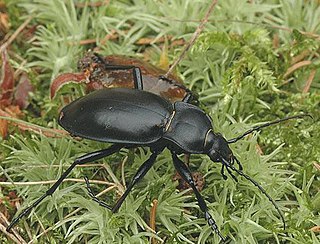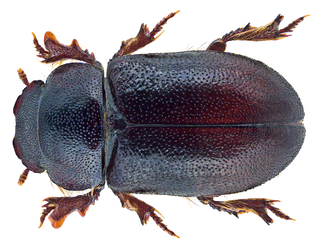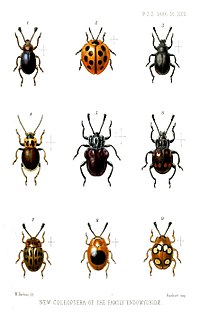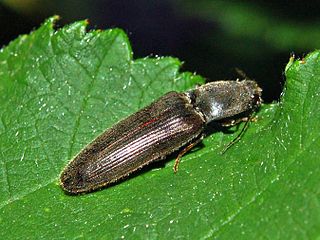
Phyllobius is a genus of weevils containing at least 60 described species, some of which are commonly found in Europe.

Carabus is a genus of beetles in family Carabidae. The genus is highly diverse with 91 subgenera and more than 1000 recognised species, thus is the largest genus in the subfamily Carabinae. The vast majority are native to the Palearctic, but 11 Nearctic species are also known. Carabus spp. are 12–50 mm (0.47–1.97 in) long, and most species are wingless and often very colourful. These are nocturnal, predatory beetles that feed on snails, earthworms, and caterpillars.

Cheirodes is a genus of darkling beetles in the Melanimini tribe. It was formerly known as Anemia until 1973, when T. J. Spilman determined Anemia to be a synonym of CheirodesGéné, 1839.

Endomychidae, or handsome fungus beetles, is a family of beetles with representatives found in all biogeographic realms. There are around 120 genera and 1300 species. The family was established based on the type genus Endomychus, a genus erected in 1795 by Panzer which was applied to a species that Linnaeus called Chrysomela coccinea. As the common name suggests, Endomychidae feed on fungi. Crowson, in his influential treatment of the beetles, placed the family within the Cucujoidea. They have a tarsal formal of 4-4-4 or 3-3-3 and the wings lack a closed radial cell. The second antennal segment has a sensory appendage that is as long as the third antennal segment. The family has also been grouped with the Coccinellidae in a group called the Trimera for having pseudotrimerous tarsi. A 2015 molecular phylogeny study found that the Cucujoidea were found to be non-monophyletic and the Endomychidae was refined with the removal of the Anamorphinae from within the family and elevated to the status of a full family, Anamorphidae. Mycetaeinae and Eupsilobiinae were also found not to belong within the clades of the core Endomychidae, and likewise reclassified into the families Mycetaeidae and Eupsilobiidae.

Alexiidae is a family of beetles, in the suborder Polyphaga, formerly included within the family Cerylonidae. Alexiidae are very small, almost half spherical beetles with clubbed antennae. They are fungivores found in leaf litter or decaying wood. The family contains the single genus Sphaerosoma with the following species:

Athous is a genus of click beetles belonging to the family Elateridae

Cyphicerini is a tribe of oriental broad-nosed weevils in the subfamily of beetles known as Entiminae.

Galerucini is a tribe of skeletonizing leaf beetles in the family Chrysomelidae. There are more than 70 genera and at least 480 described species in Galerucini.

Mecinus is a genus of true weevils in the family of beetles known as Curculionidae. There are at least 90 described species in Mecinus.

Stephanocleonus is a genus of cylindrical weevils in the beetle family Curculionidae. There are at least 70 described species in Stephanocleonus.

Trachodes is a genus of true weevils in the family of beetles known as Curculionidae. There are at least 30 described species in Trachodes.











